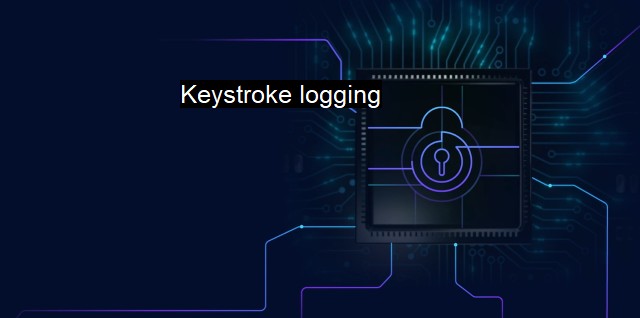What is Keystroke logging?
Understanding Keystroke Logging: Applications, Risks, and Detection Methods to Protect Yourself
Keystroke logging, also known as keylogging or keyboard capturing, isn't a new concept in the cybersecurity arena. It is a prevalent method used for cyber spying and hacking, posing serious threats to both individual privacy and organizational security. As sophisticated cyber threats are on the rise, comprehending keystroke logging comes to the forefront to increase cyber resilience and online safety.Keystroke logging is a malicious activity used by threat actors to record every keystroke made on a targeted device - a computer, smartphone, or tablet. This method allows hackers to gather critical information, such as usernames, passwords, credit card numbers, and other sensitive user data without the victims realizing that their digital information is being harvested.
Undeniably, these hacking techniques are well embedded in cybercrime structure as they provide easy access to a bounty of valuable personal and financial information. The recorded data is subsequently used for unauthorized access to a wide variety of digital platforms and financial institutes, largely contributing to identity theft, online fraud, corporate espionage, and large-scale data breaches.
There are several ways hackers can use keystroke logging for their unscrupulous activities. Hardware keyloggers, software keyloggers, acoustic keyloggers, and electromagnetic emissions are among the most widely employed methods. Hardware keyloggers are physical devices that are connected between the keyboard and the computer. Software keyloggers are computer programs that broadly encompass malware, spyware, and other malicious codes that can be incorporated in seemingly harmless applications or utilities.
An especially sophisticated type of keyloggers is kernel-based keyloggers. These nefarious tools infect the core computing functions of a device and can evade normal detection methods. Similarly, memory-injecting keyloggers modify existing software on the device to perform keystroke logging functions, making both types highly evasive and increasingly menacing.
In the current digital era, keystroke logging has expanded beyond offline activities and penetrated various online mediums. Spear phishing, an ascendant technique, exploits human trust by impersonating trusted sources, prompting users to input their credentials - an optimal opportunity for keyloggers to store detailed records.
Despite being a serious cyber threat, there are various countermeasures that individuals and organizations can adopt to squelch or completely divert keystroke logging attempts. Firstly, the installation of robust antivirus software is imperative. These curated programs are designed to detect and eliminate malicious activities, such as keyloggers, from the user's device. A vigilant antivirus would not only protect against known keyloggers but also track and arrest new variants based on behavioral traits.
In addition to the vigilant antivirus program, a comprehensive anti-malware suite offers crucial shields against note recording tools, closely examining downloads, email attachments, dubious links, phishing attacks, and other malware-spreading mechanisms incorporating keystroke loggers.
A particularly effective deterrent is an updated firewall, which curtails unauthorized access to your digital devices. regularly updated software significantly reduces the likelihood of possessing known vulnerabilities that keyloggers and other malware take advantage of.
Lastly, adopting safe computing practices can augment the defenses generated by the technical tools. This includes regularly updating passwords, verifying external links before clicking, double-checking emails for suspicious content, and being aware of the common indicators of phishing techniques.
To summarize, keystroke logging is a powerful and insidious cyber threat that exploits negligent digital security practices and lax defense measures, aggravating cybersecurity vulnerabilities. with a vigilant antivirus program, updated software/hardware, and conscious digital behavior, this risk can be significant mitigated. The dual effort of implementing advanced technical defenses and boosting cybersecurity awareness hence plays an indispensable role for heightened resilience against advanced cyber threats like keystroke logging.

Keystroke logging FAQs
What is keystroke logging?
Keystroke logging is the process of tracking and recording every keystroke made on a computer, including usernames, passwords, and other sensitive information.Why do cybersecurity experts use keystroke logging?
Cybersecurity experts use keystroke logging as a tool to detect and prevent hacking attempts, as well as to investigate and monitor suspicious activity on a computer system.How does antivirus software detect keystroke logging?
Antivirus software can detect keystroke logging by monitoring the behavior of programs and processes on a computer, and by searching for specific patterns of key presses that are commonly associated with keystroke logging.What can individuals do to protect themselves from keystroke logging?
Individuals can protect themselves from keystroke logging by using strong passwords, keeping their antivirus software up-to-date, and avoiding downloading or opening suspicious files and emails. They can also use anti-keylogging software, which encrypts keystrokes and prevents them from being captured by unauthorized sources.| | A | | | B | | | C | | | D | | | E | | | F | | | G | | | H | | | I | | | J | | | K | | | L | | | M | |
| | N | | | O | | | P | | | Q | | | R | | | S | | | T | | | U | | | V | | | W | | | X | | | Y | | | Z | |
| | 1 | | | 2 | | | 3 | | | 4 | | | 7 | | | 8 | | |||||||